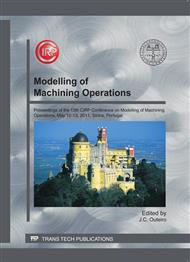[1]
M. Bono, J. Ni. A Model for predicting the heat flow into the workpiece in dry drilling, Manufacturing Science and Engineering, Vol. 124: (2002), pp.773-777.
DOI: 10.1115/1.1511176
Google Scholar
[2]
B. Ozcelik, E. Bagci. Experimental and numerical studies on the determination of twist drill temperature in dry drilling: A new approach, Materials and Design, Vol. 27: (2006), pp.920-927.
DOI: 10.1016/j.matdes.2005.03.008
Google Scholar
[3]
G. Johnson, W. Cook. Fracture Characteristics of three metals subjected to various strains, strain rates, temperatures and pressures, Engineering Fracture Mechanics, Vol. 2: (1985), pp.31-48.
DOI: 10.1016/0013-7944(85)90052-9
Google Scholar
[4]
T. Umeda, K. Mimura, Numerical evaluation of measurement accuracy of non coaxial Hopkinson bar method, International Journal Series A Solid Mechanics and materials Engineering, Vol. 48: (2005), pp.215-221.
DOI: 10.1299/jsmea.48.215
Google Scholar
[5]
M. Baker, J. Rosler, C. Siemers, Finite element simulation of segmented chip formation of Ti6Al4V, Journal of Manufacturing Science and Engineering (Trans ASME), Vol. 124: (2002), pp.485-488.
DOI: 10.1115/1.1459469
Google Scholar
[6]
H. Fassi, L. Bousschine, A. Chaaba , A. Elharif, Numerical simulation of orthogonal cutting by incremental elasto-plastic analysis and finite element method, Journal of Materials Processing Technology, Vol. 141: (2003), pp.181-188.
DOI: 10.1016/s0924-0136(02)01018-x
Google Scholar
[7]
E. Ng, T. El Wardany, M. Dumitrescu, M. Elbestawi. Physics-based simulation of high speed machining. Machining Science and Technology, Vol. 6: (2002), pp.301-329.
DOI: 10.1081/mst-120016248
Google Scholar
[8]
Y. Yen, A. Jain, T. Altan, A finite element analysis of orthogonal machining using different tool edge geometries, Journal of Materials Processing Technology Vol. 146: (2004), pp.72-81.
DOI: 10.1016/s0924-0136(03)00846-x
Google Scholar
[9]
G. Shi, X. Deng, C. Shet, A finite element study of the effect of friction in orthogonal metal cutting, Finite Elements in Analysis and Design, Vol. 38: (2002), pp.863-883.
DOI: 10.1016/s0168-874x(01)00110-x
Google Scholar
[10]
X. Yang, C.H. Liu. A new stress-based model of friction behaviour in machining and its significant impact on residual stresses computed by finite element method. International Journal of Mechanical Sciences, Vol. 44: (2002), pp.703-723.
DOI: 10.1016/s0020-7403(02)00008-5
Google Scholar
[11]
C. Liu, Y.Guo. Finite element analysis of the effect of sequential cuts and tool - chip friction on residual stresses in a machined layer, International Journal of Mechanical Sciences, 42: (2000), pp.1069-1086.
DOI: 10.1016/s0020-7403(99)00042-9
Google Scholar
[12]
MSC.Marc User's Guide Version 2005. MSC Software Corporation LA.
Google Scholar
[13]
B. Ozcelik, E. Bagci. Investigation of the effect of drilling conditions on the twist drill temperature during step-by-step and continuous dry drilling, Materials and Design, Vol. 27: (2006), pp.920-927.
DOI: 10.1016/j.matdes.2004.11.018
Google Scholar
[14]
T. Ueda, R. Nozaki, A. Hosokawa. Temperature Measurement of Cutting Edge in Drilling- Effect of Oil Mist. Annals of the CIRP, Vol. 56: (2007), pp.446-454.
DOI: 10.1016/j.cirp.2007.05.024
Google Scholar
[15]
M. Bono, J. Ni. The effects of thermal distortions on the diameter and cylindricity of dry drilled holes. International Journal of Machine Tools and Manufacture, Vol. 41: (2001), pp.2261-2270.
DOI: 10.1016/s0890-6955(01)00047-5
Google Scholar


